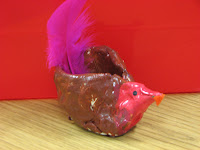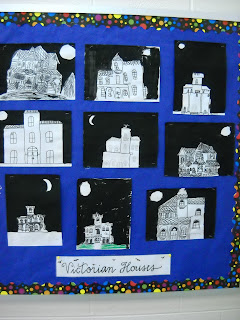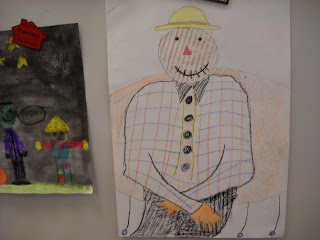Tuesday, November 30, 2010
Paper plate turkey-3rd grade
The students love this project. You will need 2 paper plates per student. Before the class, use one paper plate per child to create a cone (staple it). The children will cut across the bottom of the cone. That cut off portion becomes the turkey's wing, the upper portion is the body. Fold down the point of the cone to create the beak and face. The second plate is divided, not quite in half, to create 2 sections of the turkey's tail (you want one section larger than the other). The two sections of tail are divided like a pie, each section painted a different color. We paint the body and wing brown, and the beak yellow, add google eyes (don't they make every elementary project better) and feet. I give out a written instruction sheet for this project that also includes pictures. My goal with the written instructions was to support SOL testing (helping the children learn to follow instructions) as well as reduced stress for me! Those who have trouble reading the instructions use reading buddies, which has not caused any conflict for me. This has been a very successful project!
Monday, November 22, 2010
More Op Art
This Op Art Lesson is very simple, but you may may make it as difficult as you wish. This is just 3 pieces of construction paper that have a simple line pattern on it. They are attatched in the middle with a brad. The pieces of paper may then be moved in any manner to change the design look....try odd shaped paper with any combination of designs/patterns, and more than one brad.
Sunday, November 21, 2010
Canopic Jars
Fifth graders are making Canopic Jars using Pringles cans;
Day 1 - We started by looking at Canopic Jars from Ancient Egypt and learned a bit of background about the 4 sons of Horus and the purpose of the jars. After the introduction, the students practiced making a head with modeling clay. They were given the choice of making one of the 4 sons of Horus or any head they chose.
Day 2 - We used Sculptamold - my first experience - to make the heads on the lids of the Pringles cans. I wish we'd used Model Magic instead. The Sculptamold was gloppy and bothered some of my students with disabilities... not to mention that it was very soft and not at all like the modeling clay they'd practiced with.
Day 3 - We papier-mached the Pringles cans and finished them with a couple of pieces of tissue paper.
Day 4 - We began by talking about hieroglyphics and Egyptian patterns. I passed out lots of examples from a Dover book on Egyptian designs, and gave each student a sheet on hieroglyphics. We then decorated our cylinders/cans with gold Sharpie paint markers, glitter glue, and regular Sharpies. We also used Tacky Glue to affix the dried Sculptamold heads on to the Pringles lids and set them aside in a separate box.
Day 5 we will paint our heads with acrylic or metallic tempera paint. I can't wait to see how they will turn out!
Day 1 - We started by looking at Canopic Jars from Ancient Egypt and learned a bit of background about the 4 sons of Horus and the purpose of the jars. After the introduction, the students practiced making a head with modeling clay. They were given the choice of making one of the 4 sons of Horus or any head they chose.
Day 2 - We used Sculptamold - my first experience - to make the heads on the lids of the Pringles cans. I wish we'd used Model Magic instead. The Sculptamold was gloppy and bothered some of my students with disabilities... not to mention that it was very soft and not at all like the modeling clay they'd practiced with.
Day 3 - We papier-mached the Pringles cans and finished them with a couple of pieces of tissue paper.
Day 4 - We began by talking about hieroglyphics and Egyptian patterns. I passed out lots of examples from a Dover book on Egyptian designs, and gave each student a sheet on hieroglyphics. We then decorated our cylinders/cans with gold Sharpie paint markers, glitter glue, and regular Sharpies. We also used Tacky Glue to affix the dried Sculptamold heads on to the Pringles lids and set them aside in a separate box.
Day 5 we will paint our heads with acrylic or metallic tempera paint. I can't wait to see how they will turn out!
Friday, November 19, 2010
Wishing tree
This lesson was an idea I modified from the Arts & Activities magazine that our school receives. I did it with first graders, but older kids would also enjoy it. Week one, we drew a tree on a 6''x8'' paper-the same size as the styrofoam. I had the class draw the trunk half the way up and then 'branch out' the limbs. I told them to place 17 leaves on their tree..it helps to give them an exact number. We then taped it to the styrofoam and retraced, pressing firmly. Tell class to place their names on the BACK of the styrofoam.The next week we took pastels and colored a 9''x12'' paper, then smoothed it with kleenex. The class then printed them. I did put the boarder on before we printed--it just seems to make everyones look a little more ''finished''. Everyone had a nice print.
Buffalo Paintings


I got this lesson from another art teacher's website, but I added the Native American symbol frame to it. I tried to squeeze it all into 2 days, so I did the background and buffalo on the first day, and then cut the buffalo out and glued it all together and added the frame the second day. I also read the book "Buffalo Woman" by Paul Goble on the second day (it's a Native American legend about how the Buffalo Nation and Native Americans became "related").
Gargoyles!



I stole this clay gargoyle lesson from Cassie several years ago. The kids LOVE this lesson, the younger ones can't wait to be in 5th grade so they can make their gargoyle. This year I changed it up a little bit. I had an overwhelming number of coffee cans and plastic containers, so I decided that the kids would also make a building for their gargoyle to live on. We looked at and discussed gothic architecture, and then created our buildings on gray paper with sharpies and white colored pencils. They turned out really nice!
Thursday, November 18, 2010
Owl Drawings
Vocabulary:
Line, pattern, convex, concave, nocturnal
Materials
Owl Moon
12x18 white drawing paper
black sharpies
owl images and books
colored pencil/watercolor
Procedure
The students will draw a V on the page upper center, add circles on each side of V, add smaller circles inside those and color in for eyes, close v off with wavy half circle at top, add V to bottom of eyes to make beak, add zigzag lines around eyes and over top but not to touch the beak, add 2nd and 3rd row of zigzag feathers, draw to curved lines(concave and convex) from near beak down to make wings not to touch at lower end of page, add outer layer to create wings on both of those lines, add feet at junction of wings near bottom of page, fill in belly with little v's for feathers or other feather like shapes, add branch and tree to complete, have students add any other details they want. The students can then add watercolor, or crayon
Art Websites
Artsonia is a great site for lesson plans. Teachers share lessons for elementary through high. There are also articles on various art topics and contests. If you are a memeber of the NAEA you can register your school for free. Also, you can have an online gallery of student work. http://www.artsonia.com/
Tuesday, November 16, 2010
Food Color Wheel
Food Color Wheels
 Materials:
Materials:
Color Wheel Handouts
Pencil
9x9 white paper
circle templates/paper plates
red, yellow, blue tempera paint (for mixing)
brushes
water
scissors
glue
card stock paper/posterboard/black constructions paper
Steps:
1. Begin by asking children to draw a banana and an apple, which they will paint yellow and red. (For younger children: pre-draw fruit shapes that they may paint in)
2. Then they may paint a number of blue dots, which will represent blueberries.
3. Ask children to draw a lime, then ask what color it should be. Instruct them in mixing green from yellow and blue, so they may paint the lime green.
4. Do the same for an orange (yellow+red), and a plum or cluster of grapes (blue+red).
5. Once painted fruits have dried, cut them out.
6. Cut a circle out of card stock/black paper.
7. Beginning with primary colors, glue "fruit" around the plate according to their colour to create a color wheel
SOLs 3.4, 3.6, 3.5, 3.4
 Materials:
Materials:Color Wheel Handouts
Pencil
9x9 white paper
circle templates/paper plates
red, yellow, blue tempera paint (for mixing)
brushes
water
scissors
glue
card stock paper/posterboard/black constructions paper
Steps:
1. Begin by asking children to draw a banana and an apple, which they will paint yellow and red. (For younger children: pre-draw fruit shapes that they may paint in)
2. Then they may paint a number of blue dots, which will represent blueberries.
3. Ask children to draw a lime, then ask what color it should be. Instruct them in mixing green from yellow and blue, so they may paint the lime green.
4. Do the same for an orange (yellow+red), and a plum or cluster of grapes (blue+red).
5. Once painted fruits have dried, cut them out.
6. Cut a circle out of card stock/black paper.
7. Beginning with primary colors, glue "fruit" around the plate according to their colour to create a color wheel
SOLs 3.4, 3.6, 3.5, 3.4
Labels:
color wheel,
Primary Colors,
secondary colors,
Third Grade
Bad Case of the Stripes
To begin this lesson I read the book A Bad Case of Stripes by David Shannon. We then drew self-portraits with sharpies, and painted stripes. The next week we made a pattern for our frame and cut the person out and glued them on. They look GREAT! It's a really good book for the beginning of the school year.
Labels:
Bad Case of Stripes,
First Grade,
Illustration,
painting,
Self portrait
Thursday, November 11, 2010
Turkey Pinch Pot

Turkey Pinch Pot
I introduced my kindergarten classes to pinch pots. After forming the pinch pot, they pinched a bit of the top together to make the turkey's head. Then they used their fingers to pinch up the back of the pot to make his tail. After they were fired, they used Jazz Gloss paint to paint the head red and body brown. After they were dry, I drew on eyes for them with a black Sharpie and hot glued a feather and beak to their turkey. The kids loved them!
Thursday, November 4, 2010
Shape dragon for second graders
Monday, November 1, 2010
Victorian Houses

I do this lesson with fifth grade students and have had great success and interest on their part. I introduce Victorian Houses as a style of architecture originally from the 1800's. I have collected many photographs of Victorian houses from all over the country which I share with my students. I've also used a print of Edward Hopper's House by the Railroad . We pay special attention to details like gingerbread trim, cat walks, dormer windows, cupolas, turrets, finials, iron gates, etc. The students draw in pencil from a photograph, or they can make up their own house. They outline with a sharpie and then paint the sky black. These are always a big hit around Halloween.
Scarecrow Model
 Fifth grade students help me make a scarecrow from recycled clothing etc. and then he models for us. Since we put him in different poses and he will sit still the entire period, he makes a great model. I use this lesson to identify and use visual texture. Students place textured items like burlap, cardboard, and corduroy under their drawing as they color in, creating a textured look to his clothing. The drawings always look great and the younger students enjoy seeing our scarecrow sitting around the Art Room for the month of October.
Fifth grade students help me make a scarecrow from recycled clothing etc. and then he models for us. Since we put him in different poses and he will sit still the entire period, he makes a great model. I use this lesson to identify and use visual texture. Students place textured items like burlap, cardboard, and corduroy under their drawing as they color in, creating a textured look to his clothing. The drawings always look great and the younger students enjoy seeing our scarecrow sitting around the Art Room for the month of October.
Subscribe to:
Comments (Atom)






